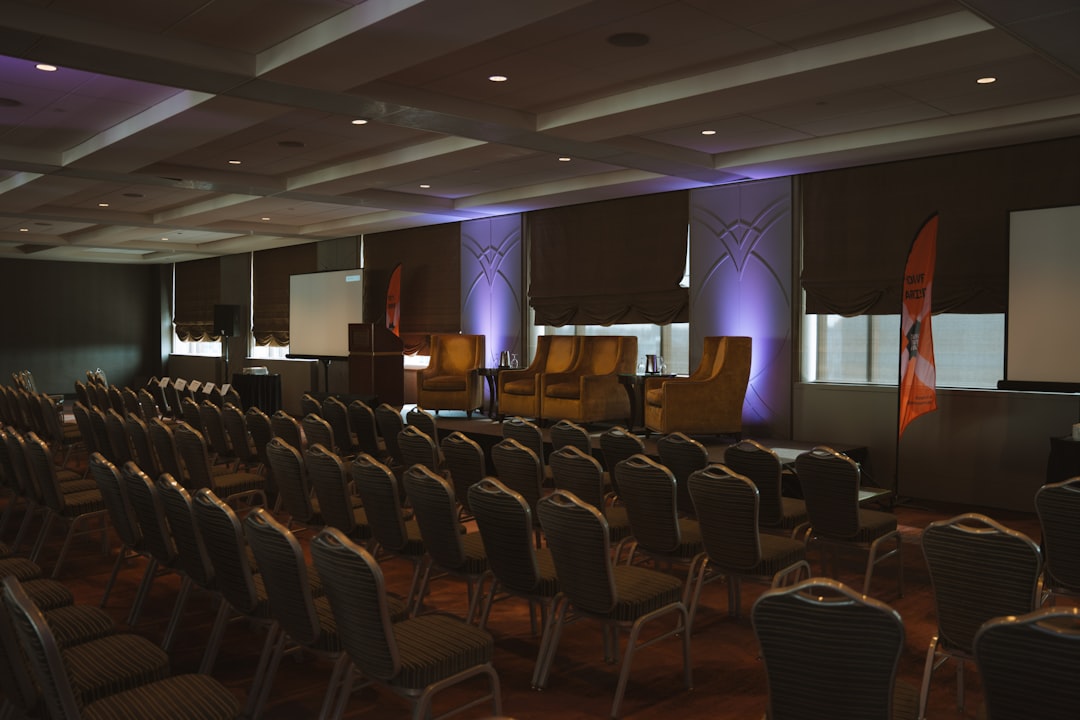

Engage prospects with a scan and streamline customer engagement with FREE QR code marketing tools by Sona – no strings attached!
Create a Free QR CodeFree consultation

No commitment

Engage prospects with a scan and streamline customer engagement with FREE QR code marketing tools by Sona – no strings attached!
Create a Free QR CodeFree consultation

No commitment
Event planning services today face mounting pressure to deliver engaging and seamless attendee experiences while clearly demonstrating ROI in a rapidly changing landscape. Many teams still grapple with analog processes such as paper sign-in sheets, static handouts, and fragmented guest lists, which make it nearly impossible to track true engagement or follow up with high-value prospects after the event. The offline-to-online gap frustrates planners and sponsors who need proof that their investment captured attention and progressed real opportunities.
A major frustration in the industry is missing out on valuable leads who interact at an event yet remain anonymous or untracked in your CRM. This lack of visibility results in lost opportunities and ineffective retargeting. QR codes have transitioned from novelty to necessity, allowing event planners to bridge this gap by instantly capturing attendance and digital interactions, transforming each scan into a measurable data point for smarter post-event marketing. With dynamic codes connected to CRM and marketing tools, every action can power segmentation, retargeting, and attribution.
Whether you are looking to streamline check-ins, boost engagement, or link every badge and brochure to an actionable digital journey, integrating QR codes opens the door to real-time insights that analog workflows miss. The result is a more connected attendee experience, less operational friction, and a measurable impact on revenue. Explore how QR-driven experiences empower event planning professionals to operate with greater agility and success.

One persistent headache for event planners is low visibility into onsite engagement. Who visited which booth, accessed which resources, or left halfway through a session often goes unrecorded, leaving organizers in the dark post-event. QR codes offer a solution by transforming previously anonymous behaviors into actionable data and enabling follow-up with previously untracked high-value prospects to amplify ROI. When every printed asset and surface becomes a digital entry point, you capture the context of interest in real time and connect it to your systems of record.
Replacing legacy processes with QR codes also improves the attendee experience. Instead of crowded registration lines and paper forms, guests self-check-in with a scan using QR code ticketing. Instead of chasing survey responses days later, feedback is captured at the moment of greatest relevance. Instead of generic follow-up emails, segmented nurture flows are driven by what each attendee actually scanned, downloaded, or attended.
Dedicated QR platforms such as Sona QR now automate code creation, routing logic, identity resolution, and analytics. This makes it practical for event teams to deploy hundreds of trackable touchpoints without heavy IT involvement.
A large conference upgraded from a manual swag desk to QR-based redemption. Attendees scanned codes on their badges to redeem gifts. The organizing team connected these scans to session attendance, booth interactions, and sponsor content downloads, which enabled targeted post-event follow-ups based on participation. This solved the challenge of anonymous foot traffic and missed touchpoints while keeping lines short and inventory under control.
The impact was twofold. First, the attendee experience improved because scanning at multiple stations replaced the need to queue repeatedly and fill in forms. Second, the team gained a clear view of which swag items influenced engagement, how traffic flowed across the venue, and which sponsor booths drove the most redemptions. The data informed future sponsor packages and helped justify premium placements with hard numbers.

Event planning services often struggle to measure true attendee engagement, particularly with guests who show interest but do not complete registration forms or post-event surveys. As a result, many high-potential leads slip through the cracks, undermining ROI measurement and the ability to nurture relationships. Sponsors want proof of value, and operators need reliable signals to focus sales outreach and content investments.
QR codes address these issues by turning every physical touchpoint into a moment of measurable action. Because a scan takes seconds and does not require an app download, people engage in the flow of the event without friction. With dynamic links, you can update destinations on the fly when agendas shift or speakers change, preserving your print assets while keeping information accurate.
By integrating QR codes at every stage, from promotions to post-event follow-up, planners gain the visibility required for strategic decisions. This supports better sponsor reporting, stronger attendee journeys, and a measurable link between engagement and pipeline.

Fragmented event communications remain a frequent challenge. Attendees often juggle paper business cards, printed guides, and scattered links across multiple channels, which creates inconsistent messaging and wasted follow-up effort. QR codes help unify these experiences by guiding participants to the right digital destination in context.
Selecting the right QR format ensures that the scan triggers the most useful action. For example, a speaker’s badge might use a vCard to save contact details instantly, while a session room sign might link directly to a live poll. Choose dynamic codes whenever you want to track performance, change destinations later, or personalize the experience.
With dynamic management through Sona QR, planners can update links and content in real time, maintain consistency as messaging evolves, and consolidate performance data across formats and placements.

Losing track of which touchpoints garner the most attention makes it difficult to identify new growth avenues or double down on what works. QR deployment creates a network of measurable digital entry points across the attendee journey, highlighting high-performing content, hot topics, and sponsor assets that deserve more budget.
When you tag each physical asset with a unique QR code, you can map scan behavior by location, time, and audience type. This provides insight into session popularity, booth appeal, and onsite patterns like morning interest in workshops versus afternoon interest in demos. The result is a data-driven framework for programming, staffing, and sponsor strategy.
Mapping QR performance by asset or location reveals hidden patterns and areas for targeted investment. Use these insights to refine your floor plan, session lineup, and incentive strategy for future events.
Traditional lead capture methods can fail to surface key accounts or high-value attendees, especially those who do not complete public forms. QR-driven interactions reduce friction, enrich identity, and funnel engagement into trackable outcomes you can act on immediately.
The strongest impact comes from deploying QR codes against specific business goals: faster entry, deeper session participation, better sponsor conversion, and richer post-event follow-up. Every use case below can be tracked and optimized in Sona QR, then synced to CRM and ad platforms for consistent nurturing.
These applications streamline attendee journeys and build intent-driven lists for post-event marketing. They also improve sponsor satisfaction with transparent engagement metrics tied to specific placements and activities. For more ideas on guest interaction, explore how events are extending on-site moments into digital follow-ups.
Failing to recognize and capture intent signals from anonymous or non-converting attendees is a persistent and costly issue in event planning. By instrumenting each touchpoint with a unique QR code, you collect clear behavioral markers that map to stages in your funnel and inform targeted outreach after the event.
Sona QR makes it easy to unify scan data with contact records, so you can move from a crowd-level view to a contact-level understanding of interests and readiness. This enables role-based messaging for planners, buyers, partners, and press, as well as personalized offers aligned to what each person engaged with onsite. To guide segmentation using behavioral signals, see Sona’s blog post on intent data.
The outcome is smarter retargeting based on real behavior rather than inference. Attendees feel seen, sponsors see value, and your pipeline reflects a clean handoff from onsite engagement to digital nurturing.
Disconnected event campaigns cause confusion, wasted budget, and inconsistent messaging, which can result in prospects falling through the cracks despite strong onsite interest. QR codes act as connectors across offline and digital touchpoints so you can enable real-time engagement and unify data across channels.
A coordinated approach also improves personalization. When a specific code on a postcard drives early-bird registration and a different code on a session slide drives resource downloads, you understand not only what worked but who took the action. This empowers your team to allocate budget with confidence and design follow-ups that resonate. For creative ideas on how to integrate QR codes across placements, explore these campaign concepts. To measure cross-channel performance, review Sona’s blog on multi-touch attribution.
QR codes serve as the offline onramp to your digital marketing engine. With a centralized platform like Sona QR, you can manage all your codes, monitor performance, and sync scan data with CRM and ad platforms for a connected, measurable funnel.
Clarify what you want to improve and how success will be measured. Event planning teams often start with reducing check-in time, driving session participation, or capturing booth leads that were previously lost. Tie your QR deployment to one priority pain point so you can prove value quickly and expand from there.
The type of code determines flexibility, tracking, and the level of personalization you can achieve. Static codes are simple and sufficient for evergreen content. Dynamic codes allow you to track scans, swap destinations after printing, and personalize based on context.
Good design boosts scan rates. People should know what they will get and why it is valuable. The code must be large enough to scan, have sufficient contrast, and include a compelling call to action that sets an expectation for the next step.
Place your codes where they will prompt the most measurable action. Think through the flow of attendees from entry to sessions to expo hall to networking, and embed codes at each moment where you want to collect a signal or drive an action.
Treat your QR deployment like any performance channel. Review scan metrics throughout the event, attribute post-event actions, and pivot while the event is live to maximize results.
A checklist that foregrounds common friction points ensures your QR campaigns deliver measurable ROI. By running this playbook at every event, you will continuously improve both attendee experience and revenue outcomes.
Lack of unified reporting remains a barrier to proving ROI and optimizing future campaigns for event professionals. Many teams can count attendees and sessions, yet struggle to connect those metrics to lead quality, pipeline, and revenue. QR-powered analytics create a single thread from physical engagement to digital outcomes, allowing you to quantify what worked and why.
The key is to go beyond scan counts and connect scans to identities, follow-up actions, and eventual conversions. Sona is an AI-powered marketing platform that turns first-party data into revenue through automated attribution, data activation, and workflow orchestration. It identifies and enriches website visitors, scores accounts by intent, and syncs audiences in real time across ad platforms and CRMs.
With Sona QR for capture and Sona.com for attribution, you can turn scattered signals into a coherent buyer journey that is visible to marketing, sales, and sponsors.
Platforms that combine QR tracking with revenue attribution give planners the evidence needed to justify investment, secure sponsor renewals, and continually improve attendee engagement.
Sustained QR performance comes from consistent execution, clear value propositions, and integrated workflows. Prioritize practices that match the physical media most common in events while supporting a clean buyer journey, from registration to post-event nurture.
Focus on the steps that reduce friction for attendees and streamline operations for your team. Quick wins build momentum and justify scaling to more placements and more advanced use cases.
Start creating QR codes for free, create a few dynamic codes for your next event, and connect them to your CRM to start building a measurable engagement engine.

Measuring true attendee impact is a common challenge for event planners. Real-world success stories demonstrate how integrated QR solutions deliver engagement at scale and make attribution visible to sponsors and stakeholders. Use these ideas as starting points and adapt them to your audience and venue.
When you design for action at the moment of interest, scan rates rise and follow-up becomes more meaningful. These examples highlight how to make scanning a seamless part of the attendee experience while generating metrics that matter.
In each example, organizers moved from anecdotal feedback to actionable, measurable data. Sponsors gained transparency, attendees got smoother experiences, and the event team secured proof of impact.
Event professionals warn of pitfalls that can undermine QR ROI. Poor code placement, weak calls to action, or static non-trackable codes disrupt the digital trail. These mistakes cause missed opportunities, wasted follow-up efforts, and uncertain campaign effectiveness. Another frequent issue is linking to slow or non-mobile pages that frustrate users and depress conversion.
Top planners recommend integrating QR tracking with event and CRM platforms for real-time identity resolution, advanced segmentation, and tailored follow-up campaigns aligned with attendee behavior. Start with dynamic codes for any destination where content may change or tracking matters. Standardize UTM parameters, brief presenters to prompt scanning, and set up alerts that notify sales or sponsor reps when priority accounts engage heavily.
Looking ahead, QR deployment will be an expected standard in events. As more platforms support predictive scoring, journey mapping, and privacy-safe identity resolution, scans will feed models that prioritize outreach and personalize experiences at the individual level. Expect deeper integration with digital signage, programmatic content on venue screens, and geotagged analytics that show how people move and interact across spaces.
QR codes are redefining what is possible for event planning services seeking measurable engagement, streamlined operations, and the ability to maximize every prospect’s digital footprint. By embedding trackable, actionable touchpoints throughout attendee journeys, planners can surface high-intent prospects, unify campaign messaging, and drive more targeted follow-up across channels. Sponsors will reward this transparency with stronger partnerships and larger investments.
Modern QR platforms connect each physical interaction to deeper analytics and automated CRM enrichment, helping teams spot upsell, cross-sell, and retention opportunities at the right moments. The result is a more consistent, data-driven view of event success and a foundation for continual improvement. If you are ready to start, spin up a set of dynamic codes in Sona QR for your next event, connect them to Sona.com for attribution, and turn every scan into a moment of measurable progress.
QR codes have revolutionized event planning services by turning every interaction into an opportunity for deeper engagement and seamless attendee experiences. From simplifying event check-ins to delivering instant access to schedules and exclusive content, QR codes help you attract more attendees, enhance their journey, and gather valuable insights to optimize future events. Imagine knowing exactly which moments spark the most excitement and being able to respond instantly to attendee preferences.
With Sona QR, creating dynamic, trackable QR codes is effortless—update your campaigns anytime without reprinting, monitor engagement in real time, and link every scan to tangible event outcomes. This means no more guesswork, just actionable data that drives smarter decisions and more successful events.
Start for free with Sona QR today and transform every scan into meaningful connections and unforgettable event experiences.
You can use QR codes to digitize agendas, feedback forms, and check-ins, link printed materials to digital content, capture attendee behavior in real time, and enable personalized follow-up, creating a seamless and measurable event experience.
Best practices include choosing dynamic QR codes for tracking and flexibility, branding codes with clear calls to action, placing codes strategically across the attendee journey, training staff to promote scanning, and continuously monitoring and optimizing scan performance.
QR codes enable real-time interaction by facilitating self-check-in, instant feedback, live polls, and access to session resources, which increases participation, captures interest signals, and delivers a more connected and personalized attendee experience.
Creative uses include linking QR codes on swag for redemption and tracking, embedding codes in direct mail for personalized RSVPs, activating dynamic signage for live polls and Q&A, and running QR-based scavenger hunts or sponsor passport programs to encourage repeated interaction.
QR codes enable attendees to self-check-in by scanning codes at entry points, eliminating paper sign-in sheets, reducing wait times, logging contact details instantly, and syncing attendance data directly with CRM systems for real-time capacity management.
Use Sona QR's trackable codes to improve customer acquisition and engagement today.
Create Your FREE Trackable QR Code in SecondsJoin results-focused teams combining Sona Platform automation with advanced Google Ads strategies to scale lead generation

Connect your existing CRM

Free Account Enrichment

No setup fees
No commitment required

Free consultation

Get a custom Google Ads roadmap for your business






Launch campaigns that generate qualified leads in 30 days or less.
